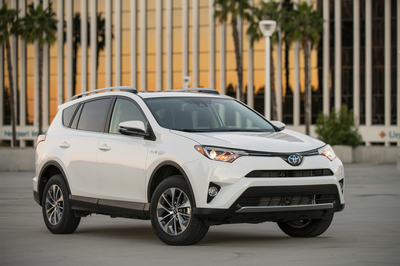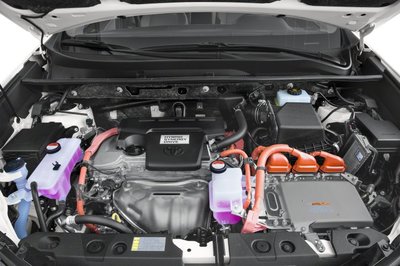2017 Toyota RAV4 Hybrid Review By Steve Purdy
2017 TOYOTA RAV4 HYBRID
Review by Steve Purdy
The Auto Channel
Michigan Bureau
Electrified vehicles still capture a tiny share (under 1%) of the U.S. auto market but we see most automakers investing large amounts of R&D into advancing a variety of hybrid and electric technologies. In fact, major automakers like BMW, Volvo, Land Rover, Lincoln and many others have announced major moves in the direction of electrification. The message we can take from all that is about the major roll electrons will play in the future of mobility.
Our test car this week is the cute and efficient hybrid RAV4 compact CUV from Toyota the company that has led within the modern hybrid space since the first Prius in the 1990s. And, they continue to lead in both the number of electrified models and in the sophistication of their proprietary Synergy hybrid system.
What a good lookin’ little thing is the RAV4. Dramatic sculpting all around gives it a distinctive look. The complex front fascia with deep cheek vents features a prominent Toyota badge within a horizontal grille piece. Sculpting along the sides move in a variety of directions keeping the eye moving. Taillights grow decisively out of the rear flank for a bit of drama at the rear as well.
Inside, we find typical Toyota thoughtful design in handiness, comfort and aesthetics. We’re not expecting a luxury car experience and, while materials, fit and finish are mostly good, I was not impressed with the seat fabric, though the seat itself was surprisingly comfortable even for a big guy like me. A small shelf across the right side of the dash and another at the base of the center stack make excellent use of limited space. The USB, auxiliary and power outlets are right where they ought to be in that base-of-the-center-stack slot. Our test car was not equipped with navigation but the multi-function screen worked well for the audio and other functions for which it is responsible.
Cargo capacity is limited only slightly by the extra batteries. We have 35.6 cubic-feet of space with rear seatbacks in place and 70.6 cubic-feet when we fold them. The biggest disadvantage is that the seatbacks do not fold entirely flat.
The hybrid powertrain in our RAV4 is certainly powerful enough for most any needs, except maybe towing. A 2.5-liter four-cylinder engine is augmented by two electric motors. Together they make 194 horsepower – well more than most competitors. A fairly smart continuously variable transmission gets that power to the road. Towing capacity is listed at a modest 1,750 pounds.
Acceleration is impressive on full throttle (well, throttle might be the wrong word here) as the electric motor combined with the gasoline engine is what gets you up to speed so quickly. The continuously variable transmission makes it seem a bit wheezy at times, but you can’t beat its efficiency. The EPA estimates you’ll get around 34 mpg in the city and 30 on the highway. We averaged just over 34 mpg in our week of varied conditions without making any effort at hyber-mileing.
RAV4 Hybrid prices begin at about $29,000 and reasonably well-equipped at that price. The only other small crossover with standard AWD is the Subaru Forester which, when comparably equipped, is just a bit lower in price. Standard are all-wheel drive, moonroof, all the new safety systems, and plenty more. You’ll pay a premium considerably over the cost of other compact CUVs in the class for this hybrid and the payback period in terms of fuel saving will be anywhere from six to twelve years depending on the variables in content, driving environment and other factors.
Driving dynamics are as good as anything in its class. We wouldn’t expect it to be particularly sporty, quick or agile, but it scores decently in all these categories. Suspension is of conventional design and tuning. Only someone with heightened skills in the evaluation of chassis dynamics would be able to find fault. And, that ain’t me.
Toyota’s new vehicle warranty covers the whole car for 3 years or 36,000 miles and the powertrain for 5 years or 60,000 miles. The hybrid components are covered for 8 years or 100,000 mile and in some states even longer.
As with any hybrid or electric car purchase you should be clear about your motives. If you’re doing it for purely cost savings on fuel, you’re probably barking up the wrong tree, as the coon hunter might say to his dogs when they get distracted on the hunt. If, on the other hand, your goal is to reduce your carbon footprint by using less fuel, than you might be onto something. As payoff periods go, the RAV4 Hybrid comes closest to making sense.
© Steve Purdy, Shunpiker Productions, All Rights Reserved
The Most In-Depth Independent Toyota Vehicle Consumer Research - Anywhere!
- Toyota Buyers Guide | Specs, Prices, Expert Reviews and Comparisons 2018-1997
- Find Your Perfect New Vehicle Match
- Toyota Reviews From The Auto Channel (1993-Present)
- The Auto Channel's Toyota Brand Archives; News, Press Releases, Reviews, Specifications, Prices, Video, Images (87,998 Annotations)




